Cisco 8201 High Level Architecture and Performance
Introduction
Released 2 years ago in late 2019, Cisco 8201 router has been widely adopted and deployed by service provider and cloud customers for core and peering roles. Based on Cisco Silicon One Q100 NPU, the first generation of this new chip family, it provides both 400GE and 100GE port options which make it perfect for peering role in a small form factor.
This short article will first cover Cisco 8201 high level internal architecture. Then, a quick and simple lab test will demonstrate how it can achieve 10.8Tbps at target Non-Drop Rate (NDR). This test will address recent concerns raised about its forwarding performance.
Cisco 8201 High Level Architecture
Cisco 8201 is the first Cisco 8000 fixed system built around a single NPU. It has 24 x QSFP56-DD 400GE and 12 x QSFP28 100GE ports, all packed in a compact 1RU form factor. Datasheet is available here.
At the heart of Cisco 8201 is the Cisco Silicon One Q100 ASIC. This NPU is capable of forwarding 10.8Tbps at a rate of 6.6Bpps. It’s made of 216 x 56G SerDes, which can be configured for differing port speeds of 10G/25G/50G using NRZ or PAM4 modulation.
The Q100 NPU architecture is built around 6 slices. Each slice handles the forwarding and feature processing for a set of physical interfaces. All of the slices are in turn interconnected by a Shared Memory Switch (SMS).
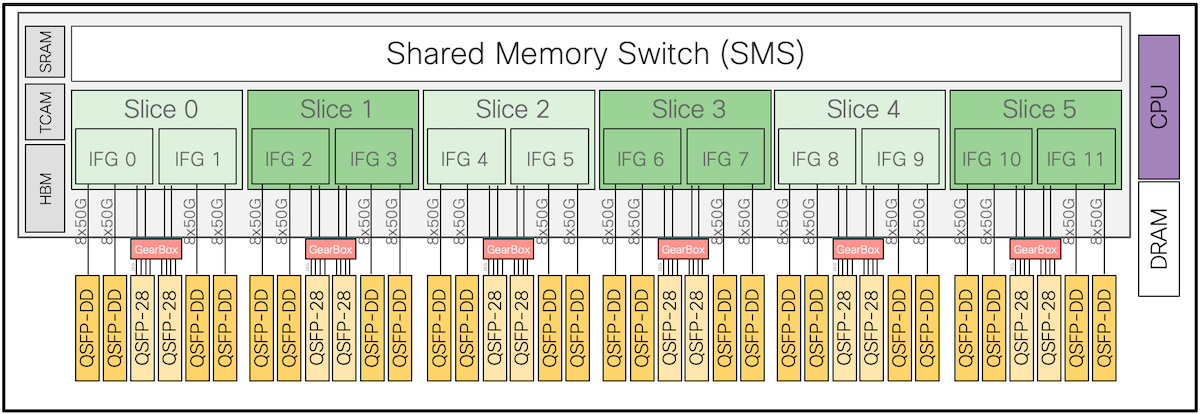
On a fixed system like Cisco 8201, the 6 slices are operating as ‘System on a Chip’ or ‘Router on a Chip’, meaning all slices interconnect network facing interfaces:
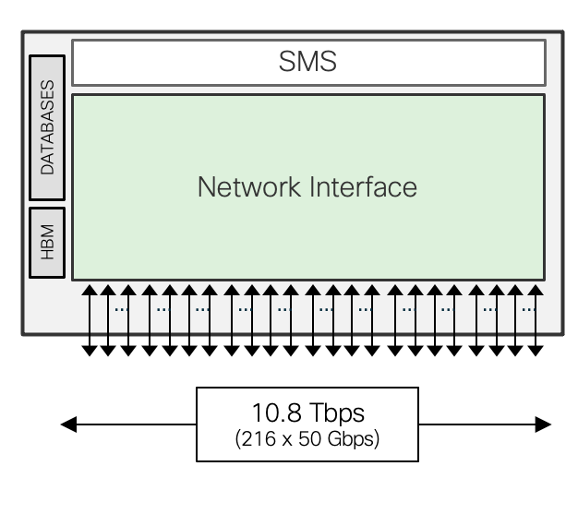
Each slice has:
- Receive and Transmit Network Processing Engines (Rx NPE and Tx NPE)
- 2 x Interface Group (IFG)
On the Q100, each IFG has 18 x 56G SerDes, providing 900Gbps of interface bandwidth. Each slice can forward one packet per clock cycle, so a system build from one Q100 NPU can thus forward six packets per clock.
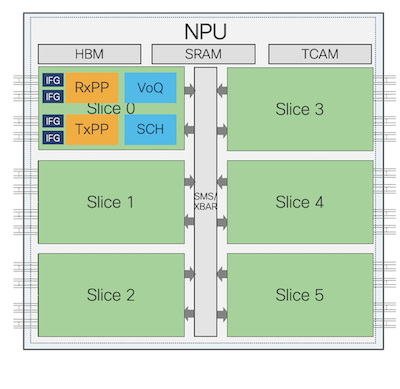
Let’s recap and do the math:
- 6 slices x 2 x IFG x 900Gbps = 10.8Tbps of available interface bandwidth
- 6 slices x 1.1Bpps = up to 6.6Bpps total switching rate.
A combination of HBM, SRAM and TCAM memories are used for packet buffering and database storage.
Add a quad-core Intel CPU, 32GB of RAM and a 64GB SSD and you have a Cisco 8201.
The mapping of individual ports to slices/IFG can be checked with following command:
RP/0/RP0/CPU0:8201#sh controllers npu voq-usage interface all instance 0 location 0/RP0/CPU0
Tue Dec 7 09:50:16.205 PST
-------------------------------------------------------------------
Node ID: 0/RP0/CPU0
Intf Intf NPU Slice IFG Sys VOQ Flow VOQ Port
name handle # # # Port base base port speed
(hex) type
----------------------------------------------------------------------
FH0/0/0/0 f000138 0 0 0 4 448 0 local 400G
FH0/0/0/23 f000140 0 1 0 96 464 0 local 400G
FH0/0/0/22 f000148 0 1 0 92 472 0 local 400G
FH0/0/0/21 f000150 0 1 1 88 480 0 local 400G
FH0/0/0/20 f000158 0 1 1 84 488 0 local 400G
FH0/0/0/19 f000160 0 2 0 80 496 0 local 400G
FH0/0/0/18 f000168 0 2 0 76 504 0 local 400G
FH0/0/0/17 f000170 0 2 1 72 512 0 local 400G
FH0/0/0/16 f000178 0 2 1 68 520 0 local 400G
FH0/0/0/15 f000180 0 3 0 64 528 0 local 400G
FH0/0/0/14 f000188 0 3 0 60 536 0 local 400G
FH0/0/0/13 f000190 0 3 1 56 544 0 local 400G
FH0/0/0/12 f000198 0 3 1 52 552 0 local 400G
FH0/0/0/1 f0001a0 0 0 0 8 456 0 local 400G
FH0/0/0/2 f0001a8 0 0 1 12 560 0 local 400G
FH0/0/0/3 f0001b0 0 0 1 16 568 0 local 400G
FH0/0/0/4 f0001b8 0 5 0 20 576 0 local 400G
FH0/0/0/5 f0001c0 0 5 0 24 584 0 local 400G
FH0/0/0/6 f0001c8 0 5 1 28 592 0 local 400G
FH0/0/0/7 f0001d0 0 5 1 32 600 0 local 400G
FH0/0/0/8 f0001d8 0 4 1 36 608 0 local 400G
FH0/0/0/9 f0001e0 0 4 1 40 616 0 local 400G
FH0/0/0/10 f0001e8 0 4 0 44 624 0 local 400G
FH0/0/0/11 f0001f0 0 4 0 48 632 0 local 400G
Hu0/0/0/24 f0001f8 0 3 0 100 640 0 local 100G
Hu0/0/0/35 f000200 0 4 1 144 656 0 local 100G
Hu0/0/0/34 f000208 0 4 0 140 672 0 local 100G
Hu0/0/0/33 f000210 0 5 1 136 688 0 local 100G
Hu0/0/0/32 f000218 0 5 0 132 704 0 local 100G
Hu0/0/0/31 f000220 0 0 1 128 720 0 local 100G
Hu0/0/0/30 f000228 0 0 0 124 736 0 local 100G
Hu0/0/0/29 f000230 0 1 1 120 752 0 local 100G
Hu0/0/0/28 f000238 0 1 0 116 768 0 local 100G
Hu0/0/0/27 f000240 0 2 1 112 784 0 local 100G
Hu0/0/0/26 f000248 0 2 0 108 800 0 local 100G
Hu0/0/0/25 f000250 0 3 1 104 816 0 local 100G
RP/0/RP0/CPU0:8201#
Lab topology
A Cisco 8201 has been staged in the lab with the latest IOS-XR version available when writing this article (7.3.2). This router is connected to 24x400G and 12x100G dedicated Spirent ports. Spirent is used to send traffic through the router at a specific packet size (200 bytes). It’s also used to measure total packet throughput (Gbps), frame rate (pps), packet loss and system latency.
Spirent configuration is attached for reference:
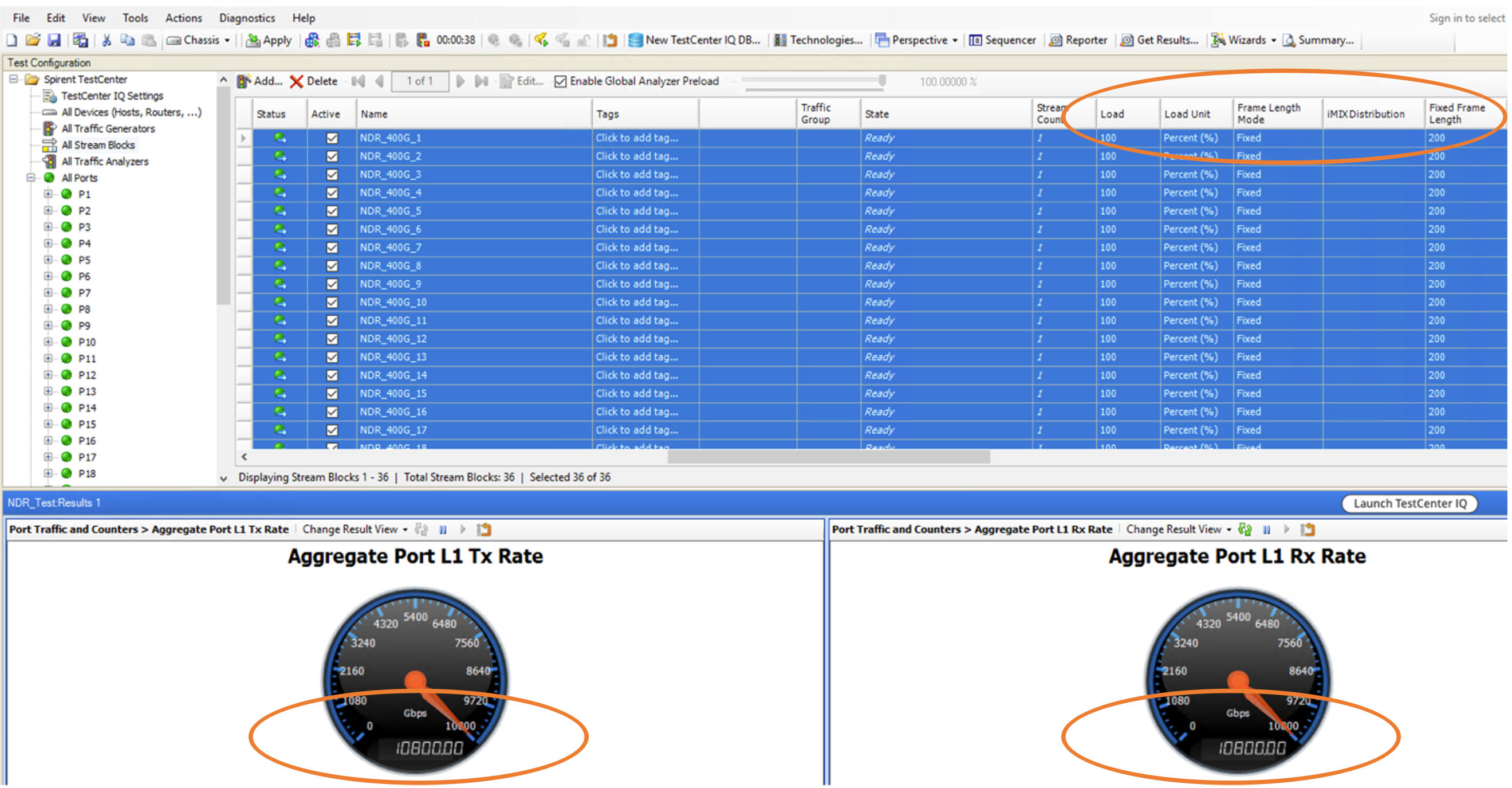
Results
As shown in the video, the Cisco 8201 is capable of forwarding the full 10.8Tbps of traffic composed of 200bytes IPv4 packets, at the sustained rate of 6Bpps.
This is achieved without any single packet loss, as shown in below screenshots.
Total frame rate: 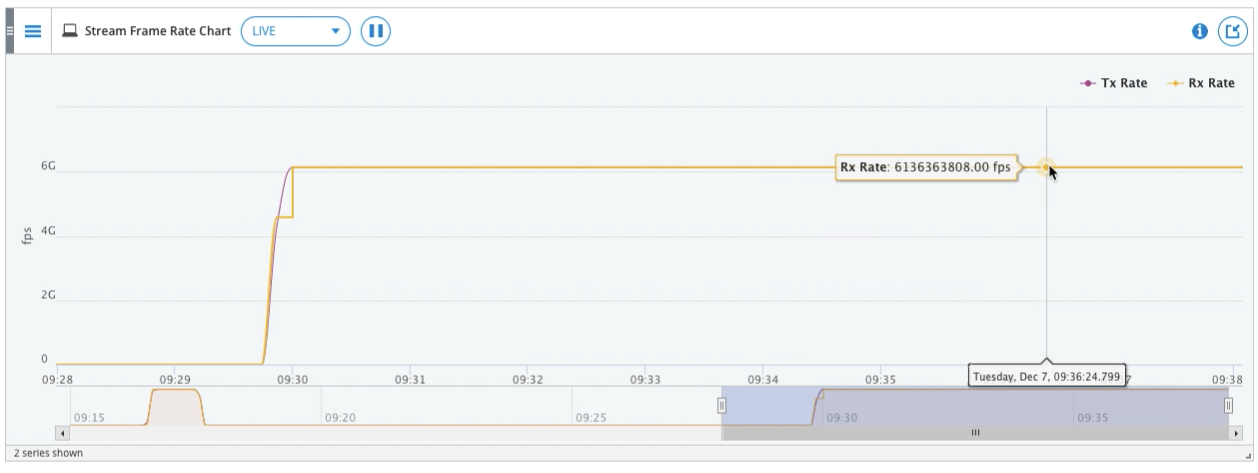
Total throughput:
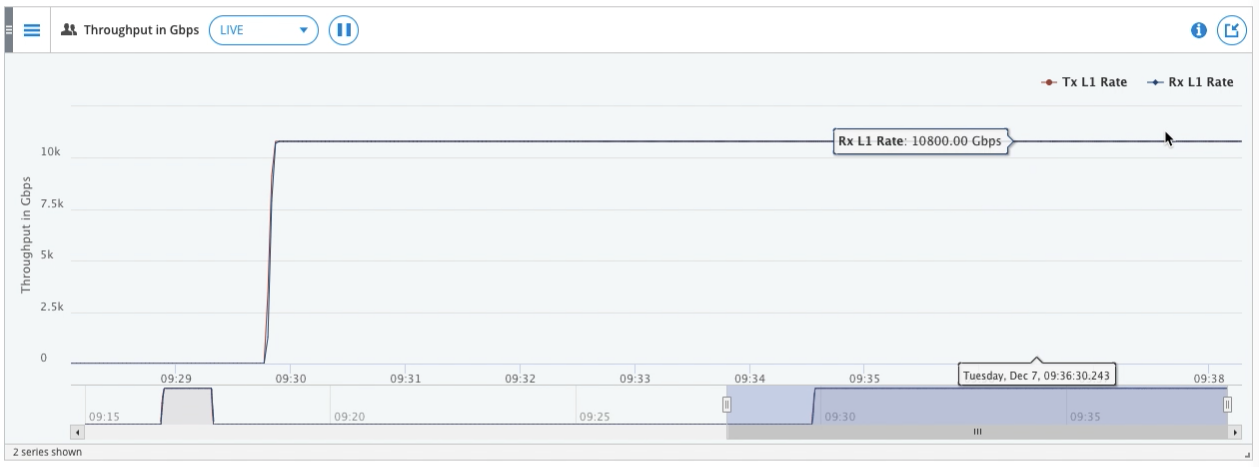
No packet loss:

Average system latency is 3.3µs: 
Same NDR is observed for IPv6 and MPLS traffic.
Conclusion
This article covered Cisco 8201 high level architecture. A simple lab test demonstrated raw Cisco 8201 forwarding capacities. Current NDR for this platform is 200 bytes for IPv4, 200 bytes for MPLS and 200 bytes for IPv6. This test confirmed Cisco Q100 performance (10.8Tbps, 6Bpps).
Seeing is believing: Cisco 8000 CPOC lab is available on dcloud. Book the lab with your account team, repeat the tests yourself, too.
A next article will cover Cisco 8201 FIB scale and performance in real life conditions.
Leave a Comment